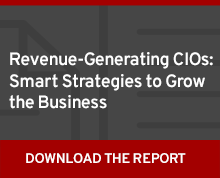Digital transformation means something slightly different for every company, but for Doug King, CIO of Landauer, it means moving from an “analog” world to one that is digitally connected. For King’s organization, the global leader in radiation science and services, it means exciting innovations coming out of (his company’s) R&D and IT organizations, and what King refers to as the “Fitbit for radiation monitoring,” and a proactive approach to uncovering and spearheading revenue-generating opportunities for the business.

King recently won the Corporate CIO of the Year award from the Chicago CIO Leadership Association for these efforts. We asked him how he fosters innovation in IT and to share advice for other CIOs working to transform IT into a revenue-generating powerhouse.
![]()
The Enterprisers Project [TEP]: How has the mandate to become more digital impacted your IT organization?

King: Our product line measures exposure to ionizing radiation, whether that’s for a worker or a patient in the healthcare world, a worker in a nuclear power plant facility, or our troops in the field in the military. Traditionally this has been an “analog” device. We extracted data off of the device and provided insights, but it was largely reactionary.
In the new world, we move to a connected digital device. I refer to it as a “Fitbit for radiation monitoring” because it provides instantaneous, actionable feedback. It informs the user about their experience that’s happening right now so that you can change behavior if you need to. Not only is the experience proactive, but the insights we can provide our users through the connected device and associated app experience are much more actionable.
And we’ll continue to build upon this connected experience. We’re already exploring future generations of the product that may contain features such as GPS tracking to provide an added layer of safety. These features and others like it are all a part of our roadmap, driven by what our customers have told us they care about. What’s exciting for my team is that they are at the heart of developing a new product platform to fulfill our clients’ needs while simultaneously keeping people safe. We’re going out in the field and meeting with clients, talking about what we need to do to change the game, and then partnering with R&D and innovation teams throughout the business to make it happen.
TEP: With IT taking on a different role, closer to the heart of business, what lessons have you learned along the way?
King: The value that we provide to customers is not the dosimeter device that they wear, it’s the data that comes from it and the actions they can take based on that data. When I came to this company eight years ago, I was excited by the vast opportunity ahead of us. At the time, we had amassed over 50-plus years of radiation data, and the opportunity in front of us was how to transform and monetize that data into a valuable digital asset and a revenue-generating line of business. And even if we were able to monetize that data, the bigger challenge was how we could make it into a long-term strategic differentiator for the business.

How did we do that? We recognized that the 50+ years of radiation data provided us with a unique perspective on our clients, a certain “stickiness” if you will. If we were to compete by building digital products and services around that data, and take advantage of that stickiness, we needed to construct an IT (Digital) Product Development organization. This organization not only needed to possess the technical know-how, but more importantly, the required client-facing and product management skills to build a strategic roadmap.
We knew from the onset that understanding of the business and our clients was the most important lever. So we started building out our Digital Product Development organization with business analysts, while also beginning to look for people who had IT product management experience with analytics and data. Where we needed to invest was in those individuals who understood product management and thus could adapt our business, our processes, and define and architect the client experience. Those product managers also needed the ability to identify, build and develop strategic partnerships with third-party software and service firms. As the technology has changed over the years, we needed to keep pace and doing so with an insourced staff was going to be costly, and constrain our ability to scale quickly.
Over the years, from the technology perspective, we’ve also had to adapt our partner ecosystem. Some 20-25 years ago it was all about ERP, followed by the continued influence of the internet, then e-commerce, then mobile, and now it’s the Internet of Things and artificial intelligence. As the technology has evolved, so have the skills of my product managers. I am not looking for them to be the technical architecture experts in areas like IoT or AI. However, what I do expect from them is that they understand the technology levers well enough in order to identify successful partners in each of those areas, and work with those partners to adapt those technologies to ensure the continued proliferation of our digital product/service roadmap.
This focus has completely reshaped the IT team at Landauer. We now possess a client-facing product management and digital innovation team comprised of people who understand our end-to-end business process internally. They understand where the opportunities are to turn the data that we have into a valuable experience for the clients. This group is our big differentiator, and as we’ve figured that out, we’ve begun hiring more and more for that mindset in IT.
TEP: How do you hire for this type of IT player? Are there specific traits you look for?
King: Every year, it gets more and more difficult. Once companies find people with this skill set, they work to lock them up and do whatever it takes to retain them. These are people who have business acumen, but understand how to apply technology. They have the ability to look outside in and understand the client perspective. They have a deep understanding of business process and know instinctively how information flows through the company on the inside. All of these skills combined create an outcome for a client that’s valuable. And from a revenue-generation perspective, they understand why and how a client will pay for that innovation.
It’s a very unique combination of skill sets to look for. I tend to look at people who are in high-tech companies working in digital marketing roles, not necessarily IT. They understand technology, but they also have an interest in building new products in a company like ours, versus perhaps working for a managed service provider. I also look for someone who wants to come in and take on more of a leadership role and who is not afraid of accountability.
TEP: What is an important leadership lesson you’ve learned?
King: Making a connection with your people is extremely important. It can be a professional connection or a personal connection. Whatever it may be, I take pride and make it a point to know my team members’ spouse’s name, how many kids they have, how old they are, etc. Never underestimate how far a simple question like “how is your son/daughter doing?” can go. It shows your team that you care. And from a leadership perspective, when you take the time to truly make that connection, loyalty goes up, motivation goes up, and people are more highly dedicated to the outcome.
I’ve also learned that a true leader is someone who can help their team see and achieve outcomes that they might never see themselves. It’s easy for teams to look at deadlines, due dates, or budgets and say, “There is no way we can do that. That’s impossible.” The ability to shift their mindset from “impossible” to “possible” and to guide them towards that outcome – that is a leadership skill that’s unique and hard to find.







